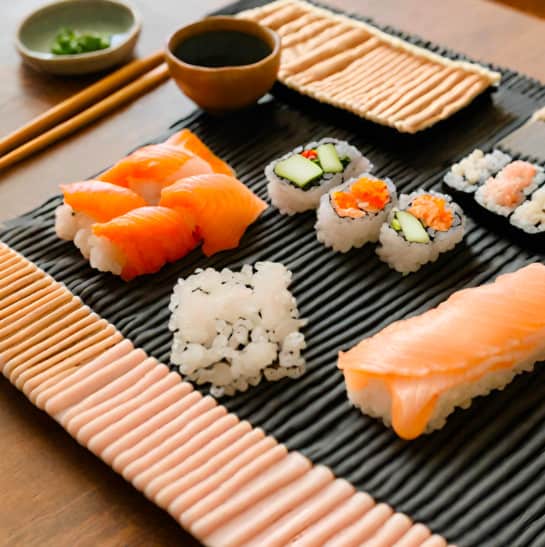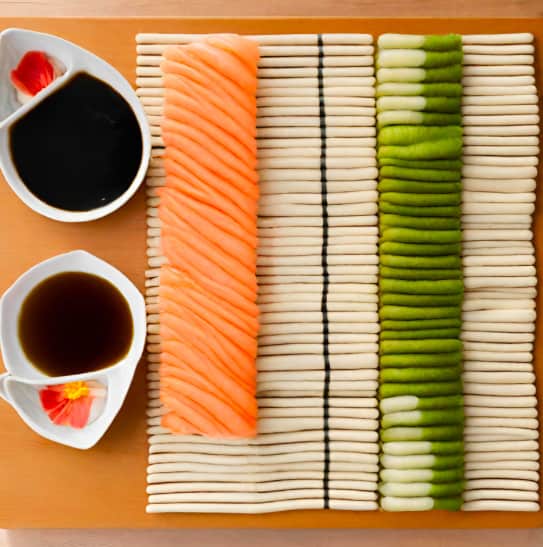
According to a sushi chef, to properly wash a sushi mat, soak it in warm water with a mild detergent for a few minutes, then rinse thoroughly and air dry it. This process ensures the mat remains clean and free from any residue that may affect the taste and quality of the sushi. (1)
Now, let’s delve into the essential steps and tips for washing your sushi mat and maintaining its longevity.

KEY TAKEAWAY
How to Wash a Sushi Mat?
To clean a sushi mat, first wash it using warm water, dishwashing liquid and a scrubbing pad to remove any stuck-on rice or residue. For bamboo mats, be sure to thoroughly rinse the mat and lay it flat to air dry completely after washing.
Why Properly Washing Sushi Mat is Essential
Sushi mats can grow mold or bacteria if not cleaned properly after use. Washing thoroughly eliminates this risk while keeping your mat in good condition. Mats soaked in vinegar water or cleaned with a scrubbing pad stay sanitized. Leaving residue invites issues that harm sushi or future users.
Proper cleaning is crucial for health safety when preparing sushi. It only takes a few minutes to clean a mat after each use, which can save you from potential foodborne illness down the road.
Just like any other kitchen tool, sushi mats require proper cleaning and hygiene practices. Taking the time to wash your mat thoroughly with soap and hot water ensures that any debris or bacteria is removed. This keeps your mat, and the sushi you make with it, free from contamination.
With regular cleaning, your mat will last longer and allow you to enjoy safe, delicious homemade sushi for many meals to come.
Understanding Different Types of Sushi Mats
Traditional bamboo sushi mats add subtle flavor but require more care.
Plastic mats are dishwasher friendly for ease but lack texture.
Silicone mats clean up simply yet don’t absorb moisture like others.
Consider your cleaning needs as well as preferred material when choosing. The right mat makes the sushi rolling experience more enjoyable.
All types of sushi mats serve the same purpose but with different pros and cons:
- Bamboo mats provide an organic texture for rolling but need to be hand washed.
- Plastic is lightweight and tossable in the dishwasher.
- Silicone cleans easily but won’t season like bamboo over time.
Thinking about how you enjoy making sushi can guide your selection of a mat that best suits your individual needs and style.
Step-by-Step Guide: Washing a Bamboo Sushi Mat
- Start by soaking in hot water with a dishwashing liquid or vinegar to lift off stuck rice.
- Let sit before gently scrubbing any residue away with a scrubs pad.
- Rinse thoroughly then lay flat to air dry.
- Store in an open area until fully dry to prevent mold.
- Weekly cleaning maintains bamboo’s natural benefits.
- Proper drying is essential when caring for a bamboo mat to prevent mold and decay.
Being gentle is important when washing a bamboo mat. The strands can splinter if scrubbed too vigorously. A soft-bristled brush or pad helps loosen debris without harming the mat. Thorough rinsing removes all soap residues. Drying flat allows air flow on both sides of the mat. Storing in a breathable area until completely dry safeguards your investment. With regular cleaning and good drying habits, a bamboo mat can provide years of use.
Step-by-Step Guide: Washing a Silicone Sushi Mat
Wipe down with a soapy cloth or rinsing under water removes most debris from these non-porous mats. Avoid abrasives that could damage the silicone. Air drying is ideal but a quick wipe keeps it freshened between uses. Convenience makes this low maintenance.
Being gentle is also key when washing silicone to prevent scuffs or wears that could affect its non-stick surface. Mild dish soap and warm water do the job well. Rinsing off any residues is important since silicone tends to attract dirt. An occasional wash is usually all that’s needed rather than deep cleaning. The pliable material makes it a good choice for quick cleanups and portable use.
Common Mistakes to Avoid When Washing a Sushi Mat
Forgetting nooks and crannies lets residue fester or mold grow. Using abrasives on delicate bamboo can damage strips. Putting away damp enables mildew. Too much bleach roughens silicone over time too. Thorough cleaning and complete drying protects your sushi tools.
It’s easy to miss hidden surfaces when quickly washing a mat. Taking the time to inspect every nook and fold is important for full sanitation. Storage is also a factor – anywhere damp will harbor germs. Learning from mistakes helps develop better routines to keep mats in prime condition for many recipe sessions.
Tips and Tricks for Easier Sushi Mat Cleaning
To remove sticky rice, rub vegetable oil on before washing. Soaking bamboo in vinegar or lemon juice disinfects and deodorizes. A quick wipe with a paper towel keeps plastic mats refreshed. Rotating more than one sushi mat saves scrubbing often. Creative solutions optimize care.
Little shortcuts make cleaning more manageable. Oiling helps lift rice without excess scrubbing. Natural solvents like vinegar refresh bamboo’s natural aroma. Quick wipes on plastic are sometimes all that’s needed. Having alternate mats means less stress to deep clean between uses. Experimenting with techniques helps tailor the best care methods.
Expert Insights: Advice from Sushi-Making Enthusiasts

One chef always hand washes with warm water and dish soap after use. This gentle routine cleans without harming the mat’s surface. Another chef prefers a diluted bleach solution once per month for sanitization purposes.
Most agree natural bamboo adds to sushi’s appeal but takes extra care like thorough drying. Seeing varied methods stimulates new ideas to suit your needs.
Experienced sushi lovers offer valuable cleaning perspectives. Professional kitchens emphasize hygienic practices over convenience when preparing food. Home enthusiasts also benefit from periodic disinfection.
While bamboo is traditional, low-maintenance options ease the process. Adapting multiple strategies empowers you to find the best routine.
Maintaining Sushi Mat Hygiene for Longevity
Regular cleaning protects mat material and removes residue that causes odor or attracts mold over time. Storing in an airtight container or resealable bag prevents loss of natural oils in bamboo too.
Proper handling and care extends the life of your sushi essentials for years of delicious rolling ahead! Small efforts make a big difference.
Simple practices safeguard your investment. Washing immediately after using retains that “like-new” condition. Covering or indoor storage shields bamboo from elements when not in use.
These lifelong hygiene habits transfer valuable life lessons as well. Caring for our tools teaches responsibility while benefiting health, wallet and love of cooking for generations to come.
Conclusion
In conclusion, washing your sushi mat is an essential step to guaranteeing food safety and maintaining the quality of your sushi.
By following proper cleaning techniques and incorporating regular maintenance into your sushi routine, you can enjoy delicious, safe, and authentic sushi experiences from the comfort of your own home.
Frequently Asked Questions
How should I clean a bamboo sushi mat?
Thoroughly wash bamboo mats by hand using warm water, dishwashing liquid and a scrubbing pad. Soaking in a mixture of hot water and vinegar helps remove stuck-on debris. Rinse well and lay flat to air dry completely.
Can sushi mats go in the dishwasher?
Plastic or silicone mats are generally dishwasher safe, but bamboo mats should always be hand washed to avoid cracking or damage. Their delicate weave requires gentle cleaning.
How often should I wash my sushi mat?
Most experts recommend washing bamboo or plastic mats after each use to prevent mold growth. Silicone can be wiped clean and stored until the next session. Mats used weekly warrant more frequent washing.
What’s the best way to clean a silicone sushi mat?
Wipe silicone mats down with a soapy cloth or sponge, then rinse. Avoid abrasive scrubbing which could damage the non-stick surface. Air drying is preferred but a quick wipe keeps it refreshed between uses.
How do I know if my bamboo mat needs replacing?
Signs like loose or broken bamboo strips, warping, persistent odor or mold indicate it’s time for a new mat. (2) Proper drying and occasional treatments with vinegar extend a bamboo rolling mat’s lifespan.
What are some tips for storing a sushi mat?
Keep bamboo mats flat and packed in an airtight container to maintain suppleness. Silicone or plastic mats can be rolled or stacked. Ensure all mats are thoroughly dry before storage to prevent mold growth.
Was this helpful?

I’m Mary R. Q. , a seasoned professional chef dedicated to elevating home cooking experiences. Through my expertise in the culinary arts, I provide practical cooking tips and insightful reviews of kitchen utensils on my blog, milkwoodrestaurant.com. As a passionate advocate for transforming everyday meals into extraordinary culinary adventures, I aim to empower home cooks with the knowledge and tools they need to create delicious and memorable dishes. I’m also an author of the book “1,001 Kitchen Tips & Tricks: Helpful Hints for Cooking, Baking, and Cleaning (1,001 Tips & Tricks)” which is sold on Amazon. Join me on a flavorful journey as we explore the art of cooking and the essential tools that make it a joy.







